View in other NatureServe Network Field Guides
NatureServe
Montana
Utah
Wyoming
Idaho
Wisconsin
British Columbia
South Carolina
Yukon
California
New York
Least Weasel - Mustela nivalis
Native Species
Global Rank:
G5
State Rank:
S4
(see State Rank Reason below)
Agency Status
USFWS:
USFS:
BLM:
External Links
State Rank Reason (see State Rank above)
Spies is infrequently observed across much of the state. It faces no known threats. Populations may have undergone moderate declines over the past decade
General Description
The smallest weasel and smallest carnivore in North America. Similar to other weasels in color and body form. Males are larger than females. Fur is brown above and whitish below during summer. Entirely white during winter. No black tip at end of short tail. Total length: less than 10 inches. Weight: one to three ounces.
Diagnostic Characteristics
Much smaller than the Short- or Long-tailed Weasel. Both Short- and Long-tailed Weasels have black tip on tail.
Species Range
Montana Range
Range Descriptions
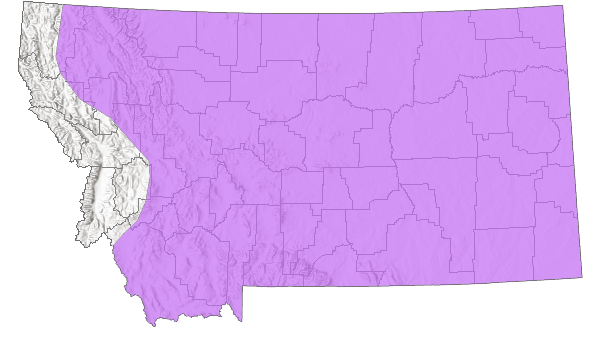
 Native
Native
Western Hemisphere Range
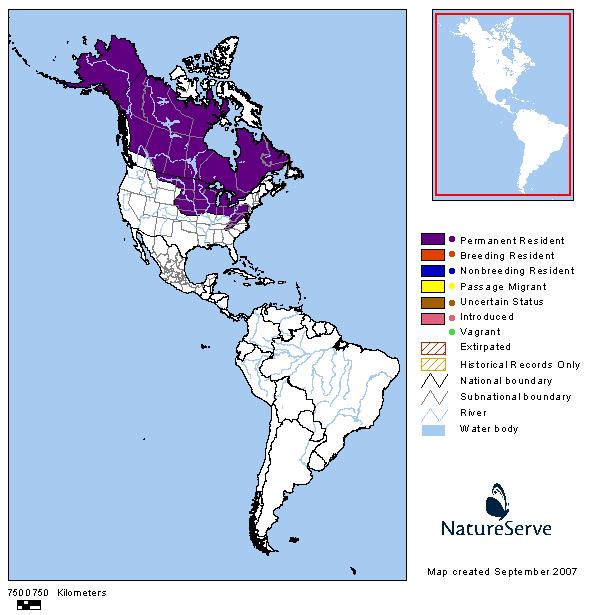
Observations in Montana Natural Heritage Program Database
Number of Observations: 95
(Click on the following maps and charts to see full sized version)
Map Help and Descriptions
Relative Density
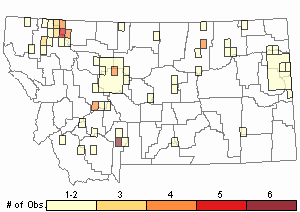
Recency
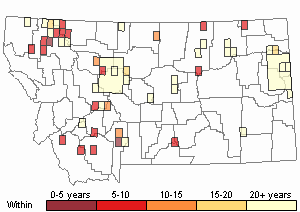
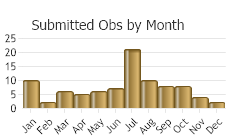
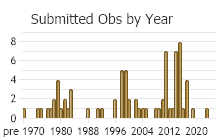
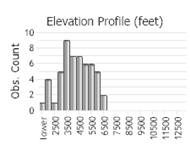 (Observations spanning multiple months or years are excluded from time charts)
(Observations spanning multiple months or years are excluded from time charts)
Migration
Non-migratory.
Habitat
Variety of habitats, including meadows, fields, brushy areas, and open woods. Avoids dense forest, prefers ecotones. Abundance of small mammals is important in determining the local distribution of Least Weasels. Marshy areas, meadows, cultivated fields, brushy areas and open woods (Svendsen 1982). Nest in shallow burrow about 5 inches underground (Jones et al. 1983).
National Vegetation Classification System Groups Associated with this Species
Forest and Woodland
Deciduous Forest and Woodland
Low Elevation - Xeric Forest and Woodland
Montane - Subalpine Forest and Woodland
Shrubland
Arid - Saline Shrubland
Foothills - Montane Shrubland
Sagebrush Shrubland
Grassland
Lowland - Prairie Grassland
Montane - Subalpine Grassland
Wetland and Riparian
Alkaline - Saline Wetlands
Alpine Riparian and Wetland
Peatland
Riparian and Wetland Forest
Riparian Shrubland
Wet Meadow and Marsh
Recently Disturbed or Modified
Insect-Killed Forest
Introduced Vegetation
Recently Burned
Human Land Use
Agriculture
Developed
Food Habits
Feeds almost entirely on mice. Small enough to pursue rodents into runways, burrows, and nest chambers. Small rodents (voles) and rabbits. Males twice as large as females, and are able to shift to the larger prey (rabbits and Water Voles). Smaller females are better able to exploit small rodent burrows (Svendsen 1982).
Ecology
Size of home ranges may increase when small rodents are scarce. Population densities fluctuate in response to changes in small mammal abundances (Svendsen 1982).
Reproductive Characteristics
Breeds year-round, young born any time of the year. Delayed implantation does not occur. Litter size 3 to 9, but usually four to five. Both male and female reproductively mature at 3 to 4 months. Males may not breed until 10 months old. Gestation 35 days. Two to three litters per year (Svendsen 1982).
Stewardship Responsibility
References
- Literature Cited AboveLegend:
 View Online Publication
View Online Publication Jones, J.K., D.M. Armstrong, R.S. Hoffmann and C. Jones. 1983. Mammals of the northern Great Plains. University of Nebraska Press, Lincoln. 379 pp.
Jones, J.K., D.M. Armstrong, R.S. Hoffmann and C. Jones. 1983. Mammals of the northern Great Plains. University of Nebraska Press, Lincoln. 379 pp. Svendsen, G. E. 1982. Weasels. Pp. 613-628 in: Hapman, J. A. and G. A. Feldhamer (eds). Wild mammals of North America. John Hopkins Univ. Press, Baltimore. 1147 pp.
Svendsen, G. E. 1982. Weasels. Pp. 613-628 in: Hapman, J. A. and G. A. Feldhamer (eds). Wild mammals of North America. John Hopkins Univ. Press, Baltimore. 1147 pp.
- Additional ReferencesLegend:
 View Online Publication
View Online Publication
Do you know of a citation we're missing? Beak Consultants, Inc. 1983. Wildlife. January 1983. In Stillwater Project Environmental Studies. Addendum A, Wildlife. Vol. I. Tech. Report No. 7. 1982.
Beak Consultants, Inc. 1983. Wildlife. January 1983. In Stillwater Project Environmental Studies. Addendum A, Wildlife. Vol. I. Tech. Report No. 7. 1982. Bowdoin NWR. 2000. A survey of the small, terrestrial mammals at Bowdoin NWR: Malta, Montana.
Bowdoin NWR. 2000. A survey of the small, terrestrial mammals at Bowdoin NWR: Malta, Montana. Chapman, J.A., and G.A. Feldhamer. 1982. Wild mammals of North America: biology, management, and economics. Johns Hopkins University Press, Baltimore, Maryland.
Chapman, J.A., and G.A. Feldhamer. 1982. Wild mammals of North America: biology, management, and economics. Johns Hopkins University Press, Baltimore, Maryland. Cross, James, and Richard P. Weckwerth, 1977, Upland Game Bird (and Fur Survey) Inventory. Wildlife Investigations, Region One. W-130-R-8, Job No. II-1, July 1, 1976 - June 30, 1977.
Cross, James, and Richard P. Weckwerth, 1977, Upland Game Bird (and Fur Survey) Inventory. Wildlife Investigations, Region One. W-130-R-8, Job No. II-1, July 1, 1976 - June 30, 1977. Cross, James, and Richard P. Weckwerth, 1978, Upland Game Bird (and Fur Survey) Inventory. Wildlife Investigations, Region One. W-130-R-9, Job No. II-1, July 1, 1977 - June 30, 1978.
Cross, James, and Richard P. Weckwerth, 1978, Upland Game Bird (and Fur Survey) Inventory. Wildlife Investigations, Region One. W-130-R-9, Job No. II-1, July 1, 1977 - June 30, 1978. Cross, James, and Richard P. Weckwerth, 1980, Upland Game Bird (and Fur Survey) Inventory. Wildlife Investigations, Region One. W-130-R-11, Job No. II-1, July 1, 1979 - June 30, 1980.
Cross, James, and Richard P. Weckwerth, 1980, Upland Game Bird (and Fur Survey) Inventory. Wildlife Investigations, Region One. W-130-R-11, Job No. II-1, July 1, 1979 - June 30, 1980. Cross, James, and Richard P. Weckwerth, 1981, Upland Game Bird (and Fur Survey) Inventory. Wildlife Investigations, Region One. W-130-R-12, Job No. II-1, July 1, 1980 - June 30, 1981.
Cross, James, and Richard P. Weckwerth, 1981, Upland Game Bird (and Fur Survey) Inventory. Wildlife Investigations, Region One. W-130-R-12, Job No. II-1, July 1, 1980 - June 30, 1981. Cross, James, and Richard P. Weckwerth, 1983, Upland Game Bird (and Fur Survey) Inventory. Wildlife Investigations, Region One. W-130-R-14, Job No. II-1, July 1, 1982 - June 30, 1983.
Cross, James, and Richard P. Weckwerth, 1983, Upland Game Bird (and Fur Survey) Inventory. Wildlife Investigations, Region One. W-130-R-14, Job No. II-1, July 1, 1982 - June 30, 1983. Dechmann, D.K.E., S. LaPoint, C. Dullin, M. Hertel, Taylor, J.R.E. Taylor, K. Zub, and M. Wikelski. 2017. Profound seasonal shrinking and regrowth of the ossified braincase in phylogenetically distant mammals with similar life histories. Scientific Reports. 7(42443)
Dechmann, D.K.E., S. LaPoint, C. Dullin, M. Hertel, Taylor, J.R.E. Taylor, K. Zub, and M. Wikelski. 2017. Profound seasonal shrinking and regrowth of the ossified braincase in phylogenetically distant mammals with similar life histories. Scientific Reports. 7(42443) Erlinger, S. 1974. Distribution, territoriality, and numbers of the weasel Mustela nivalis in relation to prey abundance. Oikos 25(3):308-314.
Erlinger, S. 1974. Distribution, territoriality, and numbers of the weasel Mustela nivalis in relation to prey abundance. Oikos 25(3):308-314. Foresman, K.R. 2001. The wild mammals of Montana. American Society of Mammalogists, Special Publication Number 12. Lawrence, KS. 278 pp.
Foresman, K.R. 2001. The wild mammals of Montana. American Society of Mammalogists, Special Publication Number 12. Lawrence, KS. 278 pp. Foresman, K.R. 2012. Mammals of Montana. Second edition. Mountain Press Publishing, Missoula, Montana. 429 pp.
Foresman, K.R. 2012. Mammals of Montana. Second edition. Mountain Press Publishing, Missoula, Montana. 429 pp. Hoffmann, R.S. and D.L. Pattie. 1968. A guide to Montana mammals: identification, habitat, distribution, and abundance. Missoula, MT: University of Montana. 133 p.
Hoffmann, R.S. and D.L. Pattie. 1968. A guide to Montana mammals: identification, habitat, distribution, and abundance. Missoula, MT: University of Montana. 133 p. Joslin, Gayle, and Heidi B. Youmans. 1999. Effects of recreation on Rocky Mountain wildlife: a review for Montana. [Montana]: Montana Chapter of the Wildlife Society.
Joslin, Gayle, and Heidi B. Youmans. 1999. Effects of recreation on Rocky Mountain wildlife: a review for Montana. [Montana]: Montana Chapter of the Wildlife Society. King, C. M. 1989. The natural history of weasels and stoats. Comstock Pub. Assoc. Ithaca, NY. 253 pp.
King, C. M. 1989. The natural history of weasels and stoats. Comstock Pub. Assoc. Ithaca, NY. 253 pp. Lechleitner, R. R. 1954. Least weasel in Glacier National Park. J. Mammal. 35:594.
Lechleitner, R. R. 1954. Least weasel in Glacier National Park. J. Mammal. 35:594. Matthews, W.L. 1980a. Wibaux-Beach comparison study: Sydney, Glendive and Plevna Study Areas. Bureau of Land Management, Miles City, MT. 50 p.
Matthews, W.L. 1980a. Wibaux-Beach comparison study: Sydney, Glendive and Plevna Study Areas. Bureau of Land Management, Miles City, MT. 50 p. Mead, E.M. and J.I. Mead. 1989. Snake Creek burial cave and a review of the Quaternary mustelids of the Great Basin. Great Basin Naturalist 49(2):143-154.
Mead, E.M. and J.I. Mead. 1989. Snake Creek burial cave and a review of the Quaternary mustelids of the Great Basin. Great Basin Naturalist 49(2):143-154. Montana Prairie Dog Working Group. 2002. Conservation plan for black-tailed and white-tailed prairie dogs in Montana. Montana Fish, Wildlife and Parks. Helena MT. 51 pp.
Montana Prairie Dog Working Group. 2002. Conservation plan for black-tailed and white-tailed prairie dogs in Montana. Montana Fish, Wildlife and Parks. Helena MT. 51 pp. Oechsli, L.M. 2000. Ex-urban development in the Rocky Mountain West: consequences for native vegetation, wildlife diversity, and land-use planning in Big Sky, Montana. M.Sc. Thesis. Montana State University, Bozeman. 73 p.
Oechsli, L.M. 2000. Ex-urban development in the Rocky Mountain West: consequences for native vegetation, wildlife diversity, and land-use planning in Big Sky, Montana. M.Sc. Thesis. Montana State University, Bozeman. 73 p. Reid, F. 2006. Peterson Field Guide to Mammals of North America, 4th Edition. Houghton Mifflin Company: Boston and New York, 608 pp.
Reid, F. 2006. Peterson Field Guide to Mammals of North America, 4th Edition. Houghton Mifflin Company: Boston and New York, 608 pp. Sheffield, S. R. and C. M. King. 1994. Mustela nivalis. Mamm. Species 454:1-10.
Sheffield, S. R. and C. M. King. 1994. Mustela nivalis. Mamm. Species 454:1-10. Stearns-Roger Inc., 1975, Environmental baseline information of the Mount Vernon Region, Montana. January 31, 1975.
Stearns-Roger Inc., 1975, Environmental baseline information of the Mount Vernon Region, Montana. January 31, 1975. Stromberg, M. R. 1981. New record of the least weasel in Wyoming. Prairie Nat. 13(2):45-46.
Stromberg, M. R. 1981. New record of the least weasel in Wyoming. Prairie Nat. 13(2):45-46. Thompson, L.S. 1982. Distribution of Montana amphibians, reptiles, and mammals. Bozeman: Montana Audubon Council. 24 pp.
Thompson, L.S. 1982. Distribution of Montana amphibians, reptiles, and mammals. Bozeman: Montana Audubon Council. 24 pp. Tschache, O.P. 1970. Effects of ecological changes induced by various sagebrush control techniques on small mammal populations. M.Sc. Thesis. Bozeman, MT: Montana State University. 51 p.
Tschache, O.P. 1970. Effects of ecological changes induced by various sagebrush control techniques on small mammal populations. M.Sc. Thesis. Bozeman, MT: Montana State University. 51 p. Zackheim, K. 1973. Exhibit H: Wildlife Study. In Ash Grove Cement Co. files.
Zackheim, K. 1973. Exhibit H: Wildlife Study. In Ash Grove Cement Co. files.
- Web Search Engines for Articles on "Least Weasel"
- Additional Sources of Information Related to "Mammals"





